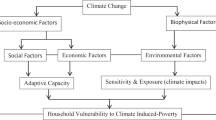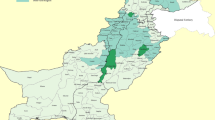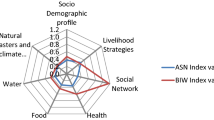Abstract
Does deprivation of assets imply an increased likelihood of vulnerability to climate change? Our study attempts to answer this question by analyzing the multidimensional poverty in rural Bihar, followed by deciphering the link between the developed poverty index and vulnerability of agriculture to climate change. Vulnerability index used in the present study was developed under the National Initiative on Climate Resilient Agriculture (NICRA) by the Government of India. As most people in rural areas and those dependent on rural based livelihood activities (such as agriculture, forestry and livestock) are more vulnerable to vagaries of weather, related attributes (i.e. land ownership, livestock ownership as well as access to agriculture equipments) are included in our analysis. We found that the extent of multidimensional poverty in rural Bihar was 0.278 indicating that rural poor were deprived in 27.8 percent of the total potential deprivations that they could experience overall. It varied from 0.19 to 0.39 across districts. The findings highlight that a majority of the population were deprived in living standard dimension, followed by health and education dimensions. Further, the districts where the multidimensional poverty was high were also more vulnerable to climate change. The study advocates for formulation of district specific programs that can target major contributing factors resulting in reducing the extent of multidimensional poverty and vulnerability.

Source Authors' calculation using the DHS data

Source Author’ calculation using the DHS data (2015–16)

Similar content being viewed by others
Notes
Anganwadi literally means courtyard shelter is a type of rural child care centre initiated by Government of India in 1975 as a part of Integrated Child Development Scheme to combat child hunger and female health.
References
Abhraham, R., & Fraker, A. (2013, May 24). Bihar's malnutrtion crisis and potential Solutions. Retrieved from Ideas For India: https://www.ideasforindia.in/topics/governance/bihars-malnutrition-crisis-and-potential-solutions.html.
Adger, W., Huq, S., Brown, K., Conway, D., & Hulme, M. (2003). Adaptation to climate change in the developing world. Progress in Development Studies, 3(3), 179–195. https://doi.org/10.1191/1464993403ps060oa
Aggarwal, S. (2018). Do rural roads create pathways out of poverty? Evidence from India. Journal of Development Economics, 133, 375–395. http://www.sciencedirect.com/science/article/pii/S0304387818300063.
Alkire, S., & Foster, J. (2011). Counting and multidimensional poverty measurement. Journal of Public Economics, 95, 476–487.
Alkire, S., & Santos, M. (2014). Measuring acute poverty in the developing world: Robustness and scope of the multidimensional poverty index. World Development, 59, 251–274. https://doi.org/10.1016/j.worlddev.2014.01.026
Alkire, S., Chatterjee, M. C., Seth, S., & Vaz, A. (2014). Poverty in rural and urban areas. Oxford Poverty and Human Development Initiative.
Balaganesh, G., Malhotra, R., Sendhil, R., Sirohi, S., Maiti, S., Ponnusamy, K., & Sharma, A. (2020). Development of composite vulnerability index and district level mapping of climate change induced drought in Tamil Nadu, India. Ecological Indicators, 113, 106197. https://doi.org/10.1016/j.ecolind.2020.106197
Banerjee, A. V., Banerji, R., Duflo, E., Glennerster, R., & Khemani, S. (2010). Pitfalls of participatory programs: Evidence from a randomized evaluation in education in India. American Economic Journal: Economic Policy, 2(1), 1–30. https://doi.org/10.1257/pol.2.1.1
Banerjee, A., Duflo, E., & Glennerster, R. (2011). Is decentralized iron fortification a feasible option to fight anemia among the Poorest? In D. A. Wise (Ed.), Explorations in the Economics of Aging (pp. 317–344). University of Chicago Press. Retrieved from http://www.nber.org/chapters/c11948.
Baqui, A. H., Rosecrans, A., Williams, E., Agrawal, P., Ahmed, S., Darmstadt, G., et al. (2008). NGO facilitation of a government community-based maternal and neonatal health programme in rural India: improvements in equity. Health Policy and Planning, 23(4), 234–243. https://doi.org/10.1093/heapol/czn012 PMID: 18562458.
Bhutta, Z. A., Das, J. K., Rizvi, A., Gaffey, M. F., Walker, N., Horton, S., et al. (2013). Evidence-based interventions for improvement of maternal and child nutrition: What can be done and at what cost? The Lancet, 382(9890), 452–477. https://doi.org/10.1016/S0140-6736(13)60996-4
Bici, R. M., & Cela, M. (2017). Education as an important dimension of the Poverty. European Journal of Multidisciplinary Studies, 2(3), 88–95. https://doi.org/10.26417/ejms.v4i3.p88-95.
Bohle, H., Downing, T., & Watts, M. (1994). Climate change and social vulnerability: Toward a sociology and geography of food insecurity. Global Environmental Change, 4(1), 37–48. https://doi.org/10.1016/0959-3780(94)90020-5
Bushamuka, V., Pee, S., Talukder, A., Kiess, L., Panagides, D., Taher, A., & Bloem, M. (2005). Impact of a homestead gardening program on household food security and empowerment of women in Bangladesh. Food and Nutrition Bulletin, 26(1), 17–25. https://doi.org/10.1177/156482650502600102
Chan, N., & Parker, D. (1996). Response to dynamic flood hazard factors in penisular Malaysia. The Geographic Journal, 162(3), 313–325.
Danaei, G., Andrews, K., Sudfeld, C. R., Fink, G., McCoy, D. C., & Peet, E. et al. (2016). Risk factors for childhood stunting in 137 developing countries: a comparative risk assessment analysis at global, regional and country levels. PLoS Medicine, https://doi.org/10.1371/journal.pmed.1002164.
Darmstadt, G., Weng, Y., Pepper, K., Ward, V., Mehta, K., et al. (2020). Impact of the Ananya program on reproductive, maternal, newborn and child health and nutrition in Bihar, India: early results from a quasi-experimental study. Journal of Global Health. https://doi.org/10.7189/jogh.10.021002
Deschingkar, P. (1998). Climate change adaptation in India: A case study of forest systems in Himachal Pradesh. International Journal of Environment and Pollution, 9(2/3), 186–197.
Drèze, J. (2001). School Participation in rural India. Review of Development Economics, 5(1), 1–24.
Duflo, E., Dupas, P., & Kremer, M. (2015). School governance, teacher incentives, and pupil–teacher ratios: Experimental evidence from Kenyan primary schools. Journal of Public Economics, 123, 92–110.
Eckstein, D., Kunzel, V., Schafer, L., & Winges, M. (2020). Global climate risk index 2020. Bonn: Germanwatch e.V. Office Bonn.
Eriksen, S., & O’Brien, K. (2007). Vulnerability, poverty and the need for sustainable adaptation measures. Climate Policy, 7(4), 337–352. https://doi.org/10.1080/14693062.2007.9685660
Gallagher, E., & Stuart, D. (2019). Crop Growers’ adaptive capacity to climate change: A situated study of agriculture in Arizona’s Verde Valley. Environmental Managemen, 63, 94–109.
Ghosh, P., & Rana, K. (2011). Elementary education in Bihar progress and challenges. Patna: Asian Development Research Institute.
GoB. (2019). Bihar economic survey 2018–19. Patna: Finance Department, Governemnt of Bihar.
GoI. (2017a). Bihar state profile 2015–16. Patna: Ministry of Micro, Small and Medium Enterprises, Governemnet of India.
GoI. (2017b). Economic survey 2016–17. New Delhi: Economic Division, Department of Economic Affairs, Ministry of Finance, Government of India.
Gould, C., & Urpelainen, J. (2018). LPG as a clean cooking fuel: Adoption, use, and impact in rural India. Energy Policy, 122, 395–408. Retrieved from https://doi.org/10.1016/j.enpol.2018.07.042
Haughton, J., & Khandker, S. (2009). Handbook on poverty and inequality. International Bank for Reconstruction and Development/ World Bank.
Idrees, M., & Baig, M. (2017). An empirical analysis of multidimensional poverty in Pakistan. FWU Journal of Social Sciences, 11(1), 297–309.
IIPS and ICF. (2015–16). National Family Health Survey (NFHS-4) 2015–16 . Retrieved from IUPM Demographic and Health Surveys (IUPM DHS): http://idhsdata.org
James, B. (2015). Educational incentives for parents and children in India. Journal of Human Resource, 4(50), 1051–1080. Retrieved from Abdul Latif Jameel Poverty Action Lab.
Kaur, B. (2019, July 13). AES in Bihar: Poor anganwadi centres failed to deliver . Retrieved from Down to Earth: https://www.downtoearth.org.in/news/health/aes-in-bihar-poor-anganwadi-centres-failed-to-deliver-65269.
Khan, J., & Mohanty, S. (2018). Spatial heterogeneity and correlates of child malnutrition in districts of India. BMC Public Health, 18, 1–13. https://doi.org/10.1186/s12889-018-5873-z
Krishna, A. (2006). Pathways out of and into poverty in 36 villages of Andhra Pradesh, India. World Development, 34(2), 271–288. http://www.sciencedirect.com/science/article/pii/S0305-750X(05)00204-4
Kumar, C. (2014, January 20). How to reduce poverty in Bihar. Retrieved from South Asia, London School of Economics (LSE): https://blogs.lse.ac.uk/southasia/2014/01/20/how-to-reduce-poverty-in-bihar/
Kumari, R. (2016). Rural-urban poverty and inequality in Bihar: A disaggregated level analysis. Journal of Rural Development, 35(2), 263–284.
Leichenko, R., & Silva, J. (2014). Climate change and poverty: Vulnerability, impacts and alleviation strategies. Wires Climate Change. https://doi.org/10.1002/wcc.287
Madhuri, T. H., & Bhowmick, P. (2014). Livelihood vulnerability index analysis: An approach to study vulnerability in the context of Bihar. Jamba: Journal of Disaster Risk Studies, 6(1), 1–13. https://doi.org/10.4102/jamba.v6i1.127
McMichael, A., Campbell-Lendrum, D., Corvalán, C., Ebi, K., Githeko, A., Scheraga, J., & Woodward, A. (2003). Climate change and human health. WHO.
MOSPI. (2019, september 29). Indian states by GDP per capita. Retrieved from tatistics Times: http://statisticstimes.com/economy/gdp-capita-of-indian-states.php
Muralidharan, K., & Prakash, N. (2017). Cycling to school: Increasing secondary school enrollment for girls in India. American Economic Journal: Applied Economics, 9(3), 321–350. https://doi.org/10.1257/app.20160004
Njiru, C., & Letema, S. (2018). Energy poverty and its implication on standardof Living in Kirinyaga, Kenya. Journal of Energy, 2018, 1–12. https://doi.org/10.1155/2018/3196567
Novotný, J., Ficek, F., Hill, J., & Kumar, A. (2018). Social determinants of environmental health: A case of sanitation in rural Jharkhand. Science of the Total Environment, 643, 762–744. https://doi.org/10.1016/j.scitotenv.2018.06.239
Noznesky, E., Ramakrishnan, U., & Martorell, R. (2010). A situation analysis of public health interventions, barriers, and opportunities for improving maternal nutrition in Bihar, India. Food Nutrition Bulletin. https://doi.org/10.1177/15648265120332S106. PMID: 22913109.
Nyqvist, B. M., Guariso, A., Svensson, J., & a. (2019). Reducing child mortality in the last mile: Experimental evidence on community health promoters in Uganda. American Economic Journal: Applied Economics, 11(3), 155–192.
Oda, H., & Tsujita, Y. (2011). The determinants of rural electrification: The case of Bihar, India. Energy Policy, 39(6), 3086–3095. Retrieved from https://doi.org/10.1016/j.enpol.2011.02.014
Panagariya, A., & Mukim, M. (2014). A Comprehensive analysis of poverty in India. Asain Development Review, 31(1), 1–52.
Paul, D. (2021). Merging the Poverty and Environment Agendas. International Institute for Sustainable Development . JSTOR. Retrieved from https://www.jstor.org/stable/resrep29274
Pelling, M. (1997). What determines vulnerability to floods; a case study in Georgetown, Guyana. Environment and Urbanization, 9(1), 203–226.
Powell, C., Walker, S. P., Chang, S., & Grantham-McGregor, S. (1998). Nutrition and education: a randomized trial of the effects of breakfast in rural primary school children. American Journal of Clinica Nutrition, 68, 873–879. https://doi.org/10.1093/ajcn/68.4.873
Rama Rao, C., Raju, B., Subba Rao, A., Rao, K. R., Ramachandran, K., Venkateswarlu, B., & Sikka, A. (2013). Atlas on vulnerability of Indian agriculture to climate change. Hyderabad: Central Research Institute for Dryland Agriculture,.
Ranjan, P., & Prakash, N. (2012). Education policies and practices: What have we learnt and road ahead for Bihar. IZA Discussion paper.
Razak, M., & Kruse, S. (2017). The adaptive capacity of smallholder farmers to climate change in the Northern Region of Ghana. Climate Risk Management, 17, 104–122.
Ruia, A., Gupta, R., & Bandhopadhyay, G., & Gupta, R. (2018). An analysis of integrated child development scheme performance in contributing to alleviation of malnutrition in two economically resurgent states. Indian Journal of Community Medicine, 43(1), 44–48. https://doi.org/10.4103/ijcm.IJCM_47_17
Samal, J. (2014). Mid day meal meanance in Bihar: The public health concerns of the tragedy. Internal Journal of Advanced Nutritional and Health Science, 1, 48–51. https://doi.org/10.23953/cloud.ijanhs.154
Sehgal, V., Singh, M., Chaudhary, A., Jain, N., & Pathak, H. (2013). Vulnerability of agriculture to climate change: District level assessment in the Indo-Gangetic Plains. New Delhi: Indian Agricultural Research Institute.
Sendhil, R., Jha, A., Kumar, A., & Singh, S. (2018). Extent of vulnerability in wheat producing agro-ecologies of India: Tracking from indicators of cross-section and multi-dimension data. Ecological Indicators, 89, 771–780. https://doi.org/10.1016/j.ecolind.2018.02.053
Sendhil, R., Kumara, K. T. M., Ramasundaram, P., Sinha, M., & Kharkwal, S. (2020a). Nutrition status in India: Dynamics and determinants. Global Food Security, 26C, 100455. https://doi.org/10.1016/j.gfs.2020.100455
Sendhil, R., Sangeetha, V., Ramasundaram, P., Kumar, A., & Singh, S. (2020b). Biofortification for enhancing nutritional outcomes and policy imperatives. In O. P. Gupta, V. Pandey, S. Narwal, P. Sharma, S. Ram, & G. P. Singh (Eds.), Wheat and Barley Grain Biofortification (pp. 309–327). Woodhead Publishing.
Sharma, A. N. (1995). Political economy of poverty in Bihar. Economic and Political Weekly, 30(41/42), 2587–2602.
Sharma, V. (2015). Are BIMARU States still Bimaru? Economic and Political Weekly, 18, 58–63.
Singh, K., & Singh, P. (2018). Challenges for ensuring food and nutritional security in Bihar. MPRA. https://mpra.ub.uni-muenchen.de/id/eprint/96679.
Sinha, A., Nagel, C., Schmidt, W., Torondel, B., Boisson, S., Routray, P., & Clasen, T. (2017). Assessing patterns and determinants of latrine use in rural settings: A longitudinal study in Odisha, India. International Journal of Hygiene and Environmental Health, 220, 906–915. https://doi.org/10.1016/j.ijheh.2017.05.004
Smit, B., Pilifosova, O., Burton, I., Challenger, B., Huq, S., Klein, R., et al. (2001). Adaptation to climate change in the context of sustainable development. Cambridge University Press.
UNDP and OPHI. (2018). Global Multidimensional Poverty Index 2018. UNDP.
UNICEF. (2013). Improving child nutrition: the achievable imperative for global progress. 1–132: Division of Communication, UNICEF. 978-92-806-4686-3.
Unjum, I., & Mishra, P. (2017). Multidimensional poverty in Uttar Pradesh: trends and patterns. Indian Journal of Economics and Development, 5(11), 1–6.
Wang, Y., & Wang, B. (2016). Multidimensional poverty measure and analysis: A case study from Hechi City, China. Springer plus, 5, 1–25.
WHO. (2018). Achieving universal access to clean and modern cooking fuels and technologies.
WHO, UNICEF. (2006). Meeting the MDG drinking and sanitation target: The urban and rural challenge of the decade. Geneva: WHO. https://apps.who.int/iris/handle/10665/43488.
Winters, P., Davis, B., & Carletto, G. (2009). Assets activities and rural income generation: Evidence from a multicountry analysis. World Development, 37(9), 1435–1452. https://doi.org/10.1016/j.worlddev.2009.01.010
Zhu, Y., & Wu, S. (2019). The association between the WASH and clean cooking fuel access and the nutritional well-being of adolescents in China. Global Social Welfare, 7, 97–107. https://doi.org/10.1007/s40609-019-00168-x
Acknowledgements
The authors are grateful to the Editor-in-Chief and reviewers for their constructive and useful comments in improving the quality of the manuscript. The authors acknowledge the support and infrastructure facilities rendered by the Director, ICAR-National Dairy Research Institute, Karnal, Haryana, India for carrying out the research.
Author information
Authors and Affiliations
Corresponding authors
Additional information
Publisher's Note
Springer Nature remains neutral with regard to jurisdictional claims in published maps and institutional affiliations.
Rights and permissions
About this article
Cite this article
Sinha, M., Sendhil, R., Chandel, B.S. et al. Are Multidimensional Poor more Vulnerable to Climate change? Evidence from Rural Bihar, India. Soc Indic Res 162, 123–149 (2022). https://doi.org/10.1007/s11205-021-02827-z
Accepted:
Published:
Issue Date:
DOI: https://doi.org/10.1007/s11205-021-02827-z




